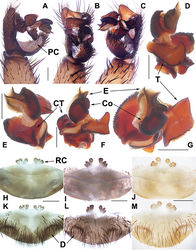Heptathela helios
| Notice: | This page is derived from the original publication listed below, whose author(s) should always be credited. Further contributors may edit and improve the content of this page and, consequently, need to be credited as well (see page history). Any assessment of factual correctness requires a careful review of the original article as well as of subsequent contributions.
If you are uncertain whether your planned contribution is correct or not, we suggest that you use the associated discussion page instead of editing the page directly. This page should be cited as follows (rationale):
Citation formats to copy and paste
BibTeX: @article{Xu2019ZooKeys888, RIS/ Endnote: TY - JOUR Wikipedia/ Citizendium: <ref name="Xu2019ZooKeys888">{{Citation See also the citation download page at the journal. |
Ordo: Araneae
Familia: Liphistiidae
Genus: Heptathela
Name
Heptathela helios Tanikawa & Miyashita, 2014 – Wikispecies link – Pensoft Profile
- Heptathela helios Tanikawa & Miyashita, 2014: 68 (holotype: male (NSMT-Ar 12851), from Kunigami-son, Okinawajima, Japan, collected by A. Tanikawa on 26 May 2010, matured on 9 September 2012, deposited in NMNS, examined).
Diagnosis
Males of H. helios can be distinguished from those of all other Okinawa group Heptathela species by the serrated contrategulum margin and the hooked tegular marginal apophysis, the ovate, indistinctly rugose conductor with a poorly serrated margin (Fig. 24D–G). Females of H. helios can be distinguished from those of all other Heptathela species by the receptacular clusters with the inner ones being smaller than the laterals, and the laterals with numerous small granulate tubercula (Fig. 24H–M). H. helios can also be diagnosed from all other Okinawa group Heptathela species by the following unique nucleotide substitutions in the standard DNA barcode alignment: T (11), T (35), G (47), A (56), C (59), A (95), T (104), A (131), T (140), T (179), C (188), C (215), G (221), C (242), C (266), C (273), C (299), C (300), C (304), T (359), G (380), T (413), A (422), T (425), T (431), G (479), G (480), G (491), G (506), C (543), T (546), G (548), C (551), C (596), T (662).
Description
Male. Carapace and opisthosoma brown, with dark brown tergites; cheliceral groove with 14 denticles; tergites closed to each other; seven spinnerets. Measurements: BL 9.88, CL 5.30, CW 4.81, OL 4.58, OW 2.92; ALE > PLE > PME > AME; leg I 16.56 (4.55 + 1.90 + 3.48 + 4.33 + 2.30), leg II 17.19 (4.50 + 2.00 + 3.34 + 4.68 + 2.67), leg III 18.35 (4.35 + 1.97 + 3.40 + 5.53 + 3.10), leg IV 23.37 (5.52 + 2.10 + 4.47 + 7.48 + 3.80).
Palp. The bulb of the two male specimens relatively distorted. Prolateral side of paracymbium unpigmented and unsclerotised, numerous setae and spines at the tip of paracymbium (Fig. 24A–C). Contrategulum with a serrated margin (Fig. 24E, G). Tegulum with a dentate dorsal extension of terminal apophysis (Fig. 24F, G), blunt terminal and hook-like marginal apophysis (Fig. 24D, F, G). Conductor sclerotised, ovate, and wide, with indistinct rugae (Fig. 24E–G). Embolus sclerotised, with a wide opening, the distal margin slightly sclerotised, and with a saddle-shaped margin in the retrolateral view (Fig. 24D–G).
Females (N = 7). Carapace and opisthosoma colour as in male; cheliceral groove with 12–14 pronounced denticles; opisthosoma with 12 well-separated tergites; seven spinnerets. Measurements: BL 11.70–14.45, CL 5.29–6.70, CW 4.29–5.81, OL 6.54–8.18, OW 4.70–6.63; ALE > PLE > PME > AME; palp 12.29 (4.20 + 2.03 + 2.63 + 3.43), leg I 14.31 (4.51 + 2.40 + 2.65 + 3.08 + 1.67), leg II 14.04 (4.25 + 2.35 + 2.53+ 3.11 + 1.80), leg III 13.75 (3.92 + 2.40 + 2.48 + 2.67 + 2.28), leg IV 21.77 (5.90 + 2.88 + 3.75 + 6.11 + 3.13).
Female genitalia. A pair of depressions on the ventro-lateral part of genital atrium (Fig. 24K–M). Paired receptacular clusters along the anterior margin of bursa copulatrix, divided into two parts, inner receptacular clusters smaller than laterals, laterals with several small tubercula, with short genital stalks (Fig. 24H–M).
Remarks
We identified the specimens collected from Ginama Dam, Okinawa, as H. helios based on evidence from morphology and COI barcode genetic distance compared with the male holotype and paratype (NSMT-Ar 12851, NSMT-Ar 12855) of H. helios in Tanikawa and Miyashita (2014)[1]. K2P and p-distances between Ginama Dam specimens and the holotype (NSMT-Ar 12851) were 3.2–3.4% and 3.1–3.3%, respectively, and those between Ginama Dam specimens and the paratype (NSMT-Ar 12855) were 1.8–2.1% and 1.7–2.1%, respectively.
Material examined
JAPAN · 2 ♂♂, 8 ♀♀; Okinawa-ken, Kunigami-son, Ginama Dam; 26.84N, 128.26E; alt. 150 m; 24 December 2012; D. Li, F.X. Liu and X. Xu leg.; XUX-2012-432 to 440C.
Distribution
The species is endemic to the Japanese island Okinawajima (Fig. 1C).
Taxon Treatment
- Xu, X; Ono, H; Kuntner, M; Liu, F; Li, D; 2019: A taxonomic monograph of the liphistiid spider genus Heptathela, endemic to Japanese islands ZooKeys, 888: 1-50. doi
Images
|
Other References
- ↑ Tanikawa A, Miyashita T (2014) Discovery of a cryptic species of Heptathela from the northernmost part of Okinawajima Is., Southwest Japan, as revealed by mitochondrial and nuclear DNA.Acta Arachnologica63(2): 65–72. https://doi.org/10.2476/asjaa.63.65

